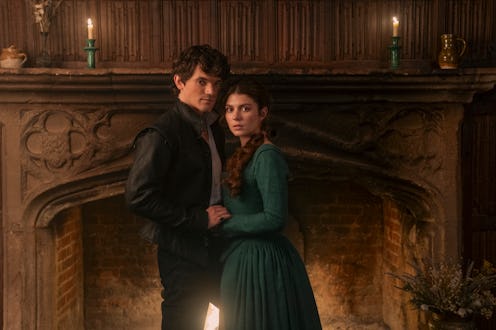TV & Movies
Is My Lady Jane’s Steamy Love Story Historically Accurate?
The show takes liberties with Jane and Guildford’s romance.

Summer is heating up — and not because of the weather. Prime Video’s historical fantasy series My Lady Jane has fans sweating over the romance between Lady Jane Grey and Lord Guildford Dudley. Played by Emily Bader and Edward Bluemel, the two have incredible chemistry that fans find “flammable” and “insane.” Whether or not their relationship is historically accurate, however, is another question.
My Lady Jane is based on the 2016 novel of the same name by Cynthia Hand, Brodi Ashton, and Jodi Meadows. Both the series and the book borrow from a tragic chapter in British history: the rise and fall of Lady Jane Grey, England’s “Nine-Day Queen” who was deposed and later executed by her cousin Mary Tudor (aka “Bloody Mary”). However, they take serious liberties with her story; the book’s authors say their story is “how we think Jane’s story should have gone.”
And what did they think Jane deserved? A hot, steamy romance, for one. In the world of the show, Jane’s husband, Guildford, is a dashing rake who happens to be able to transform himself into a horse. They’re thrown together through an arranged marriage that starts off antagonistic but turns passionate and loving.
What Does History Tell Us About Jane & Guildford?
Unfortunately, Jane and Guildford’s chemistry might not have been as combustible in real life. As in My Lady Jane, their families arranged the marriage, and she was “utterly appalled,” according to historian Nicola Tallis, author of Crown of Blood: The Deadly Inheritance of Lady Jane Grey. In an article for Tudor Times, she notes that little is known about their early days of marriage but deems it “unlikely that they formed a close relationship.” The two apparently didn’t see eye to eye when it came to their relationship dynamic. Tallis writes that Guildford expected an “obedient wife” and Jane “was not prepared to bow down to the demands of others — even those of her husband.”
The late historian Eric Ives offers another perspective in his book Lady Jane Grey: A Tudor Mystery, but it’s not necessarily more romantic. Though he references a letter she wrote to Queen Mary while imprisoned in which Jane describes herself as “a wife who loves her husband,” she also said Guildford betrayed her, along with his parents.
Unlike on the show, the young couple was ultimately executed on the same day. Before it happened, Guildford asked to see his wife one last time. No one knows what he would have said, Jane included, because she chose not to see him. She expected to reunite with him in heaven instead, where she said they would “live bound by indissoluble ties,” according to Tallis.
Alas, they don’t seem to have shared one of history’s great love stories. It’s probably best not to take history lessons from a show where people can turn into horses and birds, no matter how addicting they are.